
Sukarno was an Indonesian statesman, orator, revolutionary, and nationalist who was the first president of Indonesia, serving from 1945 to 1967.
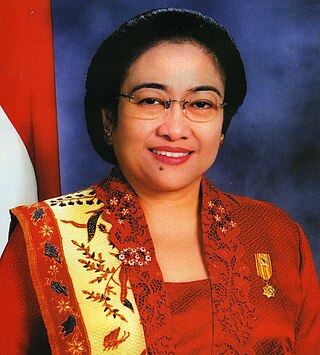
Diah Permata Megawati Setiawati Sukarnoputri is an Indonesian politician who served as the fifth president of Indonesia 2001 to 2004 and the eighth vice president under President Abdurrahman Wahid from 1999 to 2001.

The Indonesian Democratic Party was a political party in Indonesia which existed from 1973 to 2003. During the New Order era, the PDI was one of the two state-approved parties, the other being the Islam-based United Development Party (PPP).

Gelora Bung Karno Main Stadium, formerly Senayan Main Stadium and Gelora Senayan Main Stadium, is a multi-purpose stadium located at the center of the Gelora Bung Karno Sports Complex in Central Jakarta, Indonesia. It is mostly used for football matches, and usually used by the Indonesia national football team and Liga 1 club Persija Jakarta. The stadium is named after Sukarno, the then-president of Indonesia, who sparked the idea of building the sports complex.
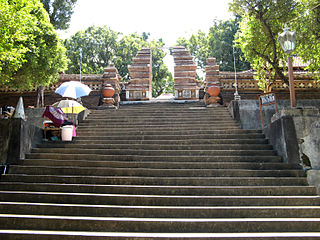
Imogiri is a royal graveyard complex in the Special Region of Yogyakarta, in south-central Java, Indonesia, as well as a subdistrict under the administration of Bantul Regency. Imogiri is a traditional resting place for the royalty of central Java, including many rulers of the Sultanate of Mataram and the current houses of Surakarta and Yogyakarta Sultanate. The name is Imagiri is derived from the Sanskrit Himagiri, which means 'mountain of snow'. The latter is another name for Himalaya.

The Indonesian National Populist Fortress Party was a political party in Indonesia. The founder, Eros Djarot was dissatisfied with the Indonesian Democratic Party of Struggle, which refused to allow him to stand as chairman against Megawati Sukarnoputri at the party conference in 2000. Eros then formed the Bung Karno National Party, named after Indonesia's first president Sukarno. As the law did not allow the use of national figures in party names, this was changed to the Freedom Bull National Party.

Gelora Bung Karno Sports Palace, is an indoor arena located in Gelora Bung Karno Sports Complex, Jakarta, Indonesia. The capacity of the arena after 2018 reopening is 7,166. This arena is usually used for badminton tournaments, especially the BWF tournaments Indonesia Open and Indonesia Masters. The first event that held in this arena was the 1961 Thomas Cup.

Javanese sacred places are locations on the Island of Java, Indonesia that have significance from either village level through to national level as sacred, and in most cases deserve visitation—usually within the context of ziarah regardless of the ethnicity or religion of the visitor. The dominant form for many places is a sacred grave, or a place associated with persons considered to have special attributes in the past—like Wali Sanga or Royalty.

The Order of Eleventh March, commonly referred to by its syllabic abbreviation Supersemar, was a document signed by the Indonesian President Sukarno on 11 March 1966, giving army commander Lt. Gen. Suharto authority to take whatever measures he "deemed necessary" to restore order to the chaotic situation during the Indonesian mass killings of 1965–66. The abbreviation "Supersemar" is also a play on the name of Semar, the mystic and powerful figure who commonly appears in Javanese mythology including wayang puppet shows. The invocation of Semar was presumably intended to help draw on Javanese mythology to lend support to Suharto's legitimacy during the period of the transition of authority from Sukarno to Suharto.
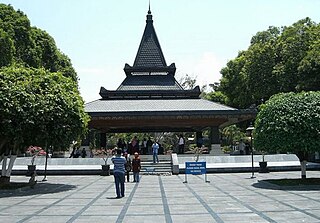
Blitar is a landlocked city in East Java, Indonesia, about 73 km from Malang and 167 km from Surabaya. The area lies within longitude 111° 40' – 112° 09' East and its latitude is 8° 06' South. The city of Blitar lies at an altitude on average 167 metres above sea level, and is an enclave within Blitar Regency which surrounds the city on all sides. It covers an area of 32.57 km2, and had a population of 131,968 at the 2010 Census and 149,149 at the 2020 Census; the official estimate as at mid 2023 was 159,781.
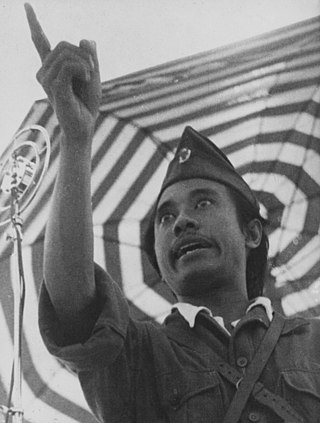
Sutomo, also known as Bung Tomo, was an Indonesian revolutionary and military leader best known for his role in the Indonesian National Revolution against Dutch colonial rule. He played a central role in Battle of Surabaya, which was fought between British and Indonesian forces from October to November 1945.
Throughout Indonesian history, the title of First Lady or, in an instance, First Gentleman has been used to refer to the wife or husband of the president of Indonesia. The constitution does not provide for the position in any sense, but it continues to hold significant influence in Indonesian society.

Fatmawati was a National Hero of Indonesia. As the inaugural first lady of Indonesia, she was the third wife of the first president of Indonesia, Sukarno, and the mother of Indonesia's first female president, Megawati Sukarnoputri. She constructed the first flag flown by Indonesia.
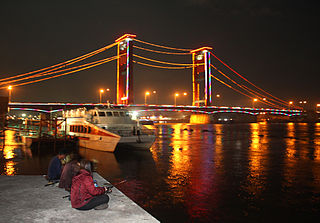
Ampera Bridge, formerly Bung Karno Bridge between its opening and the 1966 De-Sukarnoization campaign, is a vertical-lift bridge in the city of Palembang, South Sumatra, Indonesia. It connects Seberang Ulu and Seberang Ilir, two regions of Palembang. It can no longer be opened to allow ships to pass.

Indonesia and Vietnam established diplomatic relations in 1955. Indonesia has an embassy in Hanoi and a consulate general in Ho Chi Minh City while Vietnam has an embassy in Jakarta. Both are neighboring nations that have a maritime border which lies on the South China Sea and are members of ASEAN and APEC.

Sidarto Danusubroto is an Indonesian politician and a retired police officer, who is serving as a member of Indonesia's Presidential Advisory Board. A member of the Indonesian Democratic Party of Struggle, he previously served as speaker of the People's Consultative Assembly, from 2013 until 2014, following the death of Taufiq Kiemas.

Diah Permana Rachmawati Sukarnoputri was an Indonesian politician. Her father was Indonesia's founding president Sukarno and her elder sister is Megawati Sukarnoputri, who was Indonesia's fifth president.

De-Sukarnoization, also spelled de-Soekarnoization, was a purging policy that existed in Indonesia from the transition to the New Order in 1966 up to the beginning of the Reformation era in 1998, in which President Suharto intended to defame his predecessor Sukarno as well as lessen his presence and downplay his role in Indonesian history.
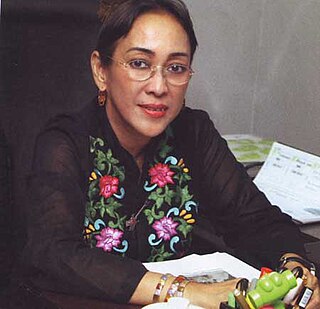
Diah Mutiara Sukmawati Sukarnoputri is the third daughter of Indonesia’s founding president Sukarno and his wife Fatmawati. Sukmawati is the younger sister of former Indonesian president Megawati Sukarnoputri and politician Rachmawati Sukarnoputri.
Hendra Rahtomo, better known as Romy Soekarno, is an Indonesian politician and businessman who is a member of the House of Representatives from the Indonesian Democratic Party of Struggle, serving since 2024. He is a grandson of first Indonesian president Sukarno and nephew of fifth president Megawati Sukarnoputri.






















